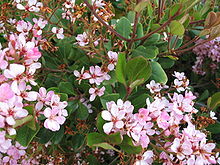| Rhaphiolepis | |
|---|---|

| |
| Rhaphiolepis indica in flower | |
| Scientific classification | |
| Kingdom: | Plantae |
| Clade: | Tracheophytes |
| Clade: | Angiosperms |
| Clade: | Eudicots |
| Clade: | Rosids |
| Order: | Rosales |
| Family: | Rosaceae |
| Subfamily: | Amygdaloideae |
| Tribe: | Maleae |
| Subtribe: | Malinae |
| Genus: | Rhaphiolepis Lindl. |
| Species | |
|
see text | |
| Synonyms[1] | |
| |
Rhaphiolepis (/ˌræfiˈɒlɪpɪs/ RAF-ee-OL-ip-iss or /ˌræfioʊˈlɛpɪs/ RAF-ee-oh-LEP-iss)[2] is a genus of about fifteen species of evergreen shrubs and small trees in the family Rosaceae, native to warm temperate and subtropical East Asia and Southeast Asia, from southern Japan, southern Korea and southern China, south to Thailand and Vietnam. In searching literature it is well to remember that the name commonly is misspelt "Raphiolepsis". The genus is closely related to Eriobotrya (loquats), so closely in fact, that members of the two genera have hybridised with each other; for example × Rhaphiobotrya, the "Coppertone loquat", is a hybrid of Eriobotrya deflexa X Rhaphiolepis indica. The common name hawthorn, originally specifically applied to the related genus Crataegus, now also appears in the common names for some Rhaphiolepis species. For example, Rhaphiolepis indica often is called "Indian hawthorn", and Rhaphiolepis umbellata, "Yeddo hawthorn".
- ^ Rhaphiolepis Lindl. Plants of the World Online. Accessed 16 December 2023.
- ^ The first pronunciation is that expected for Anglo-Latin; the second is common in nurseries. Sunset Western Garden Book, 1995:606–607. However, William T. Stearn in his book Botanical Latin says "Botanical Latin is essentially a written language, but the scientific names of plants often occur in speech. How they are pronounced really matters little provided they sound pleasant and are understood..."